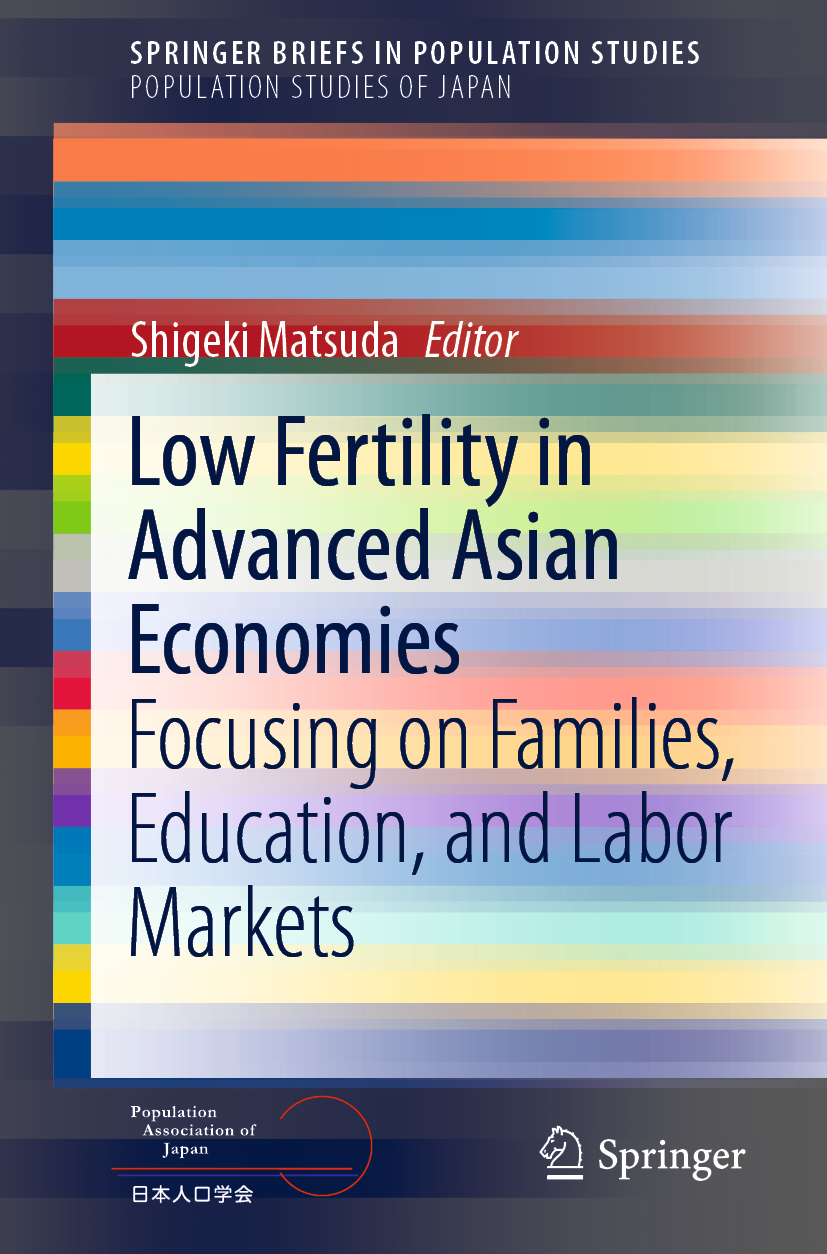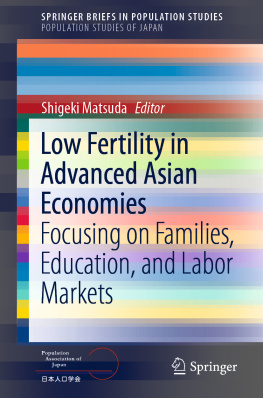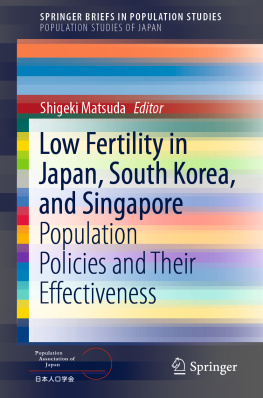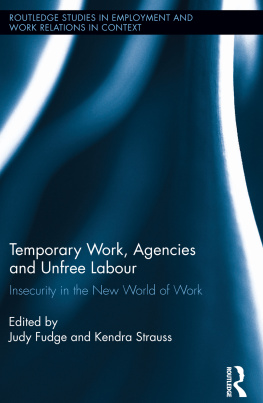Shigeki Matsuda - Low Fertility in Advanced Asian Economies: Focusing on Families, Education, and Labor Markets
Here you can read online Shigeki Matsuda - Low Fertility in Advanced Asian Economies: Focusing on Families, Education, and Labor Markets full text of the book (entire story) in english for free. Download pdf and epub, get meaning, cover and reviews about this ebook. year: 2020, publisher: Springer Nature, genre: Politics. Description of the work, (preface) as well as reviews are available. Best literature library LitArk.com created for fans of good reading and offers a wide selection of genres:
Romance novel
Science fiction
Adventure
Detective
Science
History
Home and family
Prose
Art
Politics
Computer
Non-fiction
Religion
Business
Children
Humor
Choose a favorite category and find really read worthwhile books. Enjoy immersion in the world of imagination, feel the emotions of the characters or learn something new for yourself, make an fascinating discovery.
- Book:Low Fertility in Advanced Asian Economies: Focusing on Families, Education, and Labor Markets
- Author:
- Publisher:Springer Nature
- Genre:
- Year:2020
- Rating:4 / 5
- Favourites:Add to favourites
- Your mark:
- 80
- 1
- 2
- 3
- 4
- 5
Low Fertility in Advanced Asian Economies: Focusing on Families, Education, and Labor Markets: summary, description and annotation
We offer to read an annotation, description, summary or preface (depends on what the author of the book "Low Fertility in Advanced Asian Economies: Focusing on Families, Education, and Labor Markets" wrote himself). If you haven't found the necessary information about the book — write in the comments, we will try to find it.
Shigeki Matsuda: author's other books
Who wrote Low Fertility in Advanced Asian Economies: Focusing on Families, Education, and Labor Markets? Find out the surname, the name of the author of the book and a list of all author's works by series.
Low Fertility in Advanced Asian Economies: Focusing on Families, Education, and Labor Markets — read online for free the complete book (whole text) full work
Below is the text of the book, divided by pages. System saving the place of the last page read, allows you to conveniently read the book "Low Fertility in Advanced Asian Economies: Focusing on Families, Education, and Labor Markets" online for free, without having to search again every time where you left off. Put a bookmark, and you can go to the page where you finished reading at any time.
Font size:
Interval:
Bookmark:

The world population is expected to expand by 39.4% to 9.6 billion in 2060 (UN World Population Prospects, revised 2010). Meanwhile, Japan is expected to see its population contract by nearly one third to 86.7 million, and its proportion of the elderly (65 years of age and over) will account for no less than 39.9% (National Institute of Population and Social Security Research in Japan, Population Projections for Japan 2012). Japan has entered the post-demographic transitional phase and will be the fastest-shrinking country in the world, followed by former Eastern bloc nations, leading other Asian countries that are experiencing drastic changes.
A declining population that is rapidly aging impacts a countrys economic growth, labor market, pensions, taxation, health care, and housing. The social structure and geographical distribution in the country will drastically change, and short-term as well as long-term solutions for economic and social consequences of this trend will be required.
This series aims to draw attention to Japans entering the post-demographic transition phase and to present cutting-edge research in Japanese population studies. It will include compact monographs under the editorial supervision of the Population Association of Japan (PAJ).
The PAJ was established in 1948 and organizes researchers with a wide range of interests in population studies of Japan. The major fields are (1) population structure and aging; (2) migration, urbanization, and distribution; (3) fertility; (4) mortality and morbidity; (5) nuptiality, family, and households; (6) labor force and unemployment; (7) population projection and population policy (including family planning); and (8) historical demography. Since 1978, the PAJ has been publishing the academic journalJinkogaku Kenkyu(The Journal of Population Studies), in which most of the articles are written in Japanese.
Thus, the scope of this series spans the entire field of population issues in Japan, impacts on socioeconomic change, and implications for policy measures. It includes population aging, fertility and family formation, household structures, population health, mortality, human geography and regional population, and comparative studies with other countries.
This series will be of great interest to a wide range of researchers in other countries confronting a post-demographic transition stage, demographers, population geographers, sociologists, economists, political scientists, health researchers, and practitioners across a broad spectrum of social sciences.
Series Editors
Shinji Anzo, Tokyo, Japan
Hisakazu Kato, Tokyo, Japan
Noriko Tsuya, Tokyo, Japan
Toru Suzuki, Tokyo, Japan
Kohei Wada, Tokyo, Japan
Hisashi Inaba, Tokyo, Japan
Minato Nakazawa, Kobe, Japan
Jim Raymo, Madison, USA
Ryuichi Kaneko, Tokyo, Japan
Satomi Kurosu, Chiba, Japan
Reiko Hayashi, Tokyo, Japan
Hiroshi Kojima, Tokyo, Japan
Takashi Inoue, Tokyo, Japan
More information about this subseries at http://www.springer.com/series/13101

This Springer imprint is published by the registered company Springer Nature Singapore Pte Ltd.
The registered company address is: 152 Beach Road, #21-01/04 Gateway East, Singapore 189721, Singapore
Low fertility is a widely observed phenomenon in developed countries, and the fertility in developed East and Southeast Asian countries is one of the lowest in the world (Jones et al. 2009). For example, in Japan, the total fertility rate (TFR) fell from 2.13 in 1970 to its lowest level of 1.26 in 2005. Currently, it is about 1.42 (2018), which is well below replacement level of 2.07. In some of the regions countries, such as South Korea and Singapore, the TFR rapidly and sharply dropped, and the rates are lower than that of Japan. The low fertility of these Asian countries is lower than in European countries that now are experiencing or have experienced it. Asian countries also are facing rapid declines in marriage rates, but marriage is not being replaced by cohabitation or single-parent families, neither of which is widespread in Asia. Thus, unlike Europe, declining marriage rates directly decrease fertility rates.
Asian countries economic development over the past few decades has been remarkable. However, the sustainability of those advancements is being threatened by low fertility because it will create shrinking society (Hara 2015) and negatively influence national economic growth, social welfare, and so on. In Japan, where low fertility first emerged among Asian countries, the long-term population decline is starting to negatively affect society and the national economy. A sense of crisis that Japanese societies will disappear is spreading in the country. As a countermeasure, Japans Diet passed a law on free early childhood education this year, which was premised on the sense of a crisis caused by low fertility.
Studies focused on revealing the causes or mechanisms of low fertility in Asian countries are important for understanding its characteristics and historical background. In Europe, where this phenomenon first emerged in the world, low fertility has been interpreted in the context of the second demographic transition (van de Kaa 1987), but that perspective is not a good fit for Asian low fertility. Therefore, this study identified distinctive factors causing the low fertility particular to Asia. The study has important policy implications because the affected Asian countries have responded to low fertility by implementing various countermeasures to encourage childbearing and restore their birthrates. Success has not yet been achieved, and the pace of change in the birthrates is disappointingly slow. For governments to effectively influence childbearing and marital behaviors with effective countermeasures, they must clearly understand the problem, its causes, and the factors that influence it.
Font size:
Interval:
Bookmark:
Similar books «Low Fertility in Advanced Asian Economies: Focusing on Families, Education, and Labor Markets»
Look at similar books to Low Fertility in Advanced Asian Economies: Focusing on Families, Education, and Labor Markets. We have selected literature similar in name and meaning in the hope of providing readers with more options to find new, interesting, not yet read works.
Discussion, reviews of the book Low Fertility in Advanced Asian Economies: Focusing on Families, Education, and Labor Markets and just readers' own opinions. Leave your comments, write what you think about the work, its meaning or the main characters. Specify what exactly you liked and what you didn't like, and why you think so.










